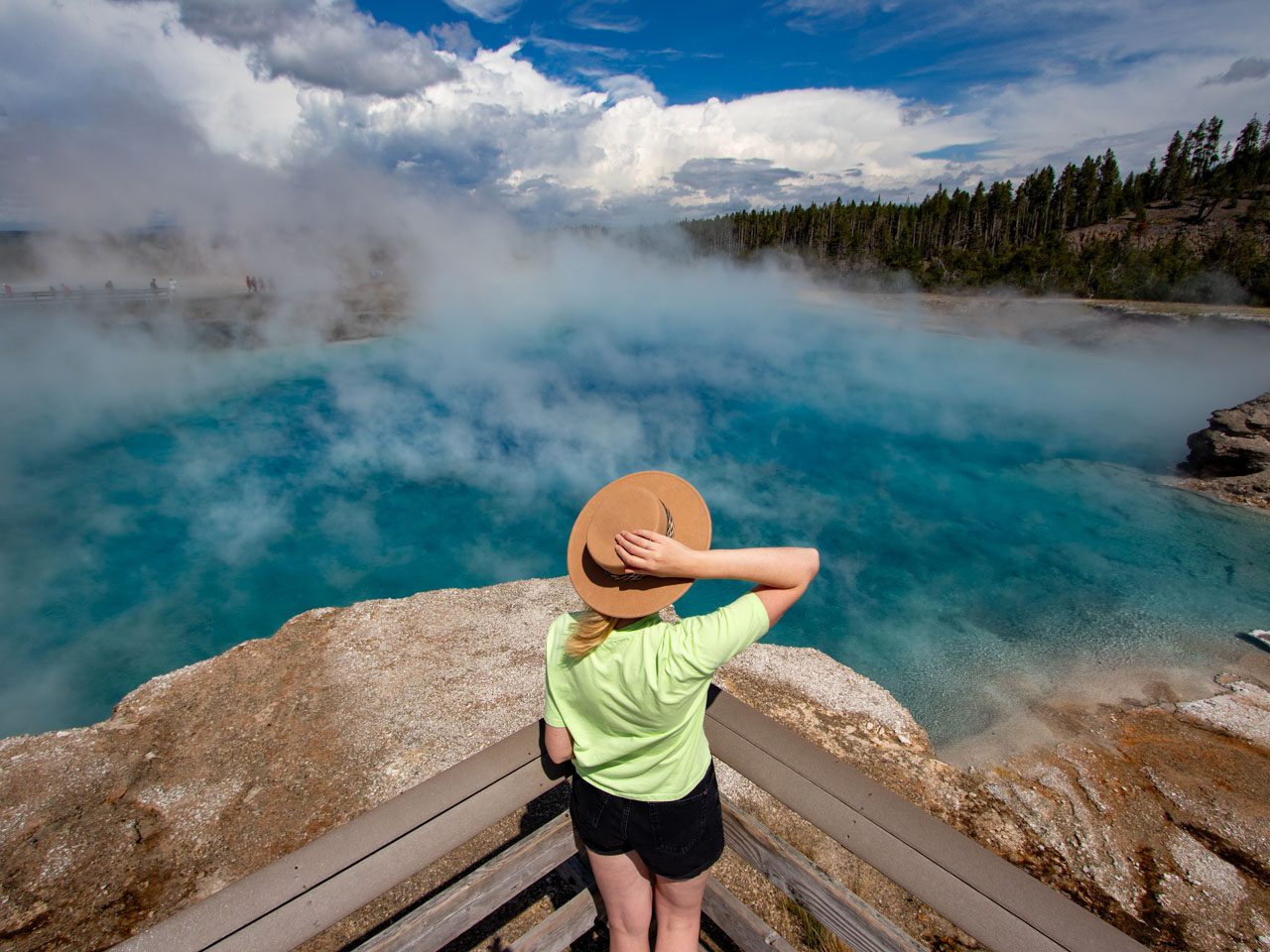There are places on the map that look like ordinary blotches.
You stare at them on your computer screen, plan your route, search for things to do in Yellowstone, scroll through Google photos… and you still don’t understand that this isn’t a “park.” This is a world.
For me, that place was Yellowstone.
We arrived in our camper in August – me, Jan, and our two cats, who had been bravely traveling with us all summer.
They had their favorite spots on the dashboard, little blankets, a stash of food, and… endless enthusiasm for watching the world through the window, as if every valley was a new fairy tale.
We spent several nights here – long mornings, quiet afternoons, and even quieter evenings when the only sound was the wind and the rumble of steam somewhere far away.
Sleeping in Yellowstone changes how you experience this place. You don’t just visit – you enter its rhythm.
Mornings here smelled of coffee brewed on a small burner and cool air that drifted into the camper van before I even pulled back the curtains.
The cats stretched like tiny jaguars before returning to their observation post at the window. And I watched the landscape that looked freshly painted in the light of the rising sun.
So this guide won’t be a list of “attractions.” It will be a story about 10 places that truly left something inside me.
About encounters, lights, scents, and moments that can’t be recreated.
Planning Your USA Trip – Start Here
If you’re just getting started with planning your American adventure, these guides will help you understand the country, pick a region, and build an itinerary:
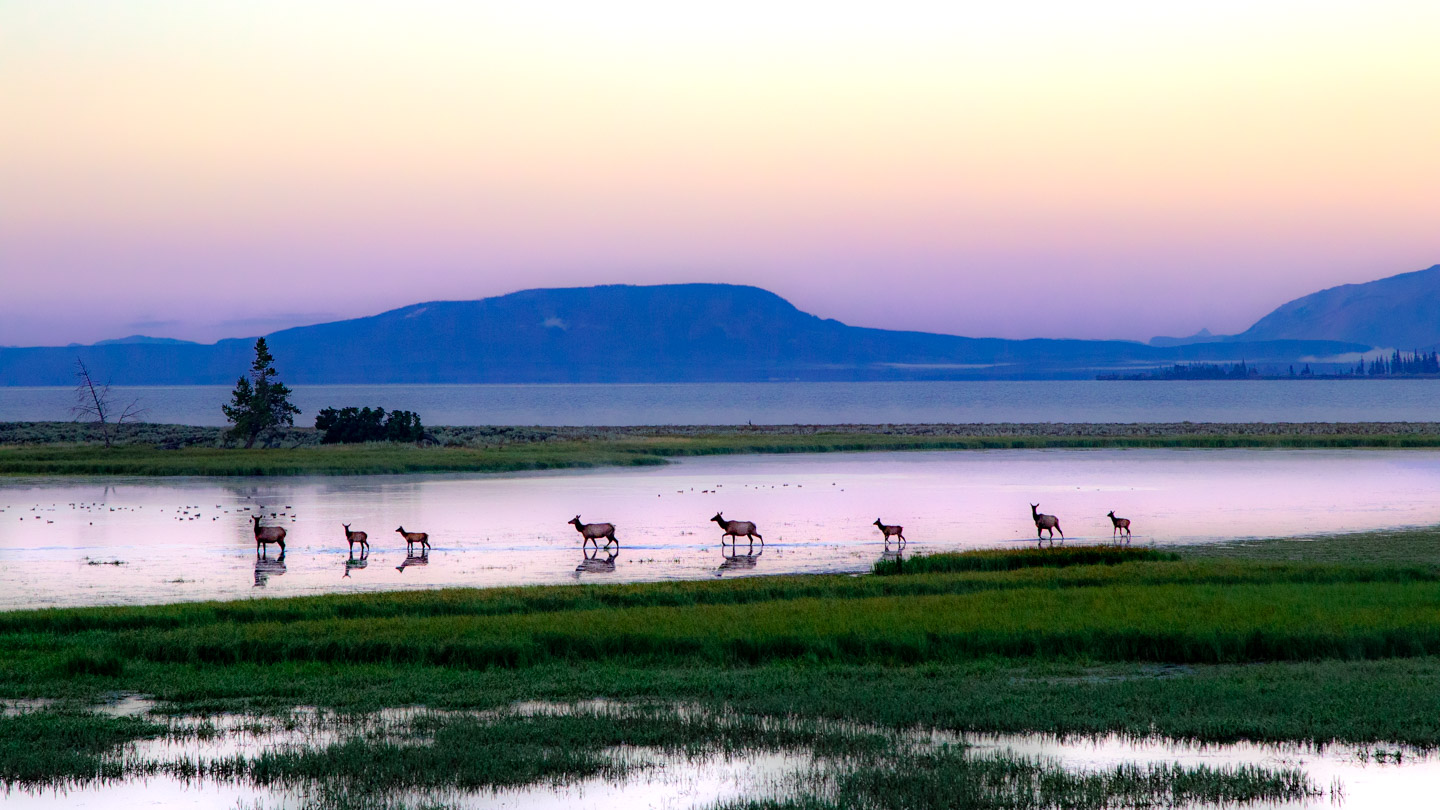
1. Old Faithful – the first morning when I felt the earth breathing
We started with Old Faithful because that’s what you’re “supposed” to do, but it quickly became one of the most beautiful memories from our first day.
We stepped out of the camper van early in the morning.
The air was cold enough to raise goosebumps. Steam rose from the geysers like fog. The cats watched through the window with that focus they reserve only for birds and… from that day on, geysers too.
We sat on the benches and waited. There was silence, but the kind where you could feel anticipation. As if everyone was listening to see if the earth had something to say yet.
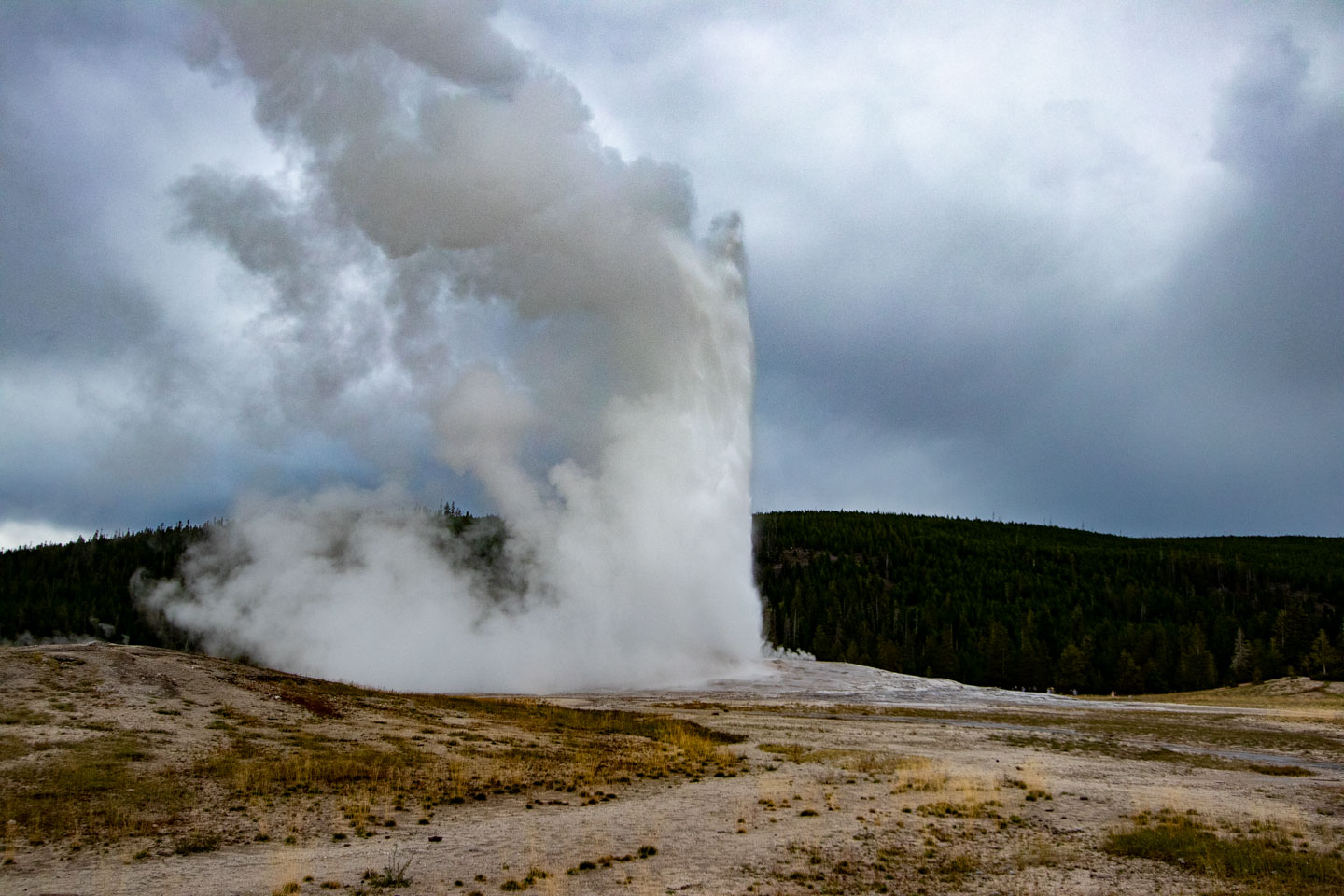
And suddenly – an eruption. Tall, regular, confident. Water shot up like a white arrow and for several minutes we all stared upward with the same wonder.
It was beautiful. Simple. Natural.
After the eruption we walked further – Castle Geyser looked like an ancient tower, and Morning Glory Pool like a colorful portal to another world.
I already knew then that Yellowstone isn’t a place to “check off.” It’s a place you want to return to the next day, at a different time, under different light.
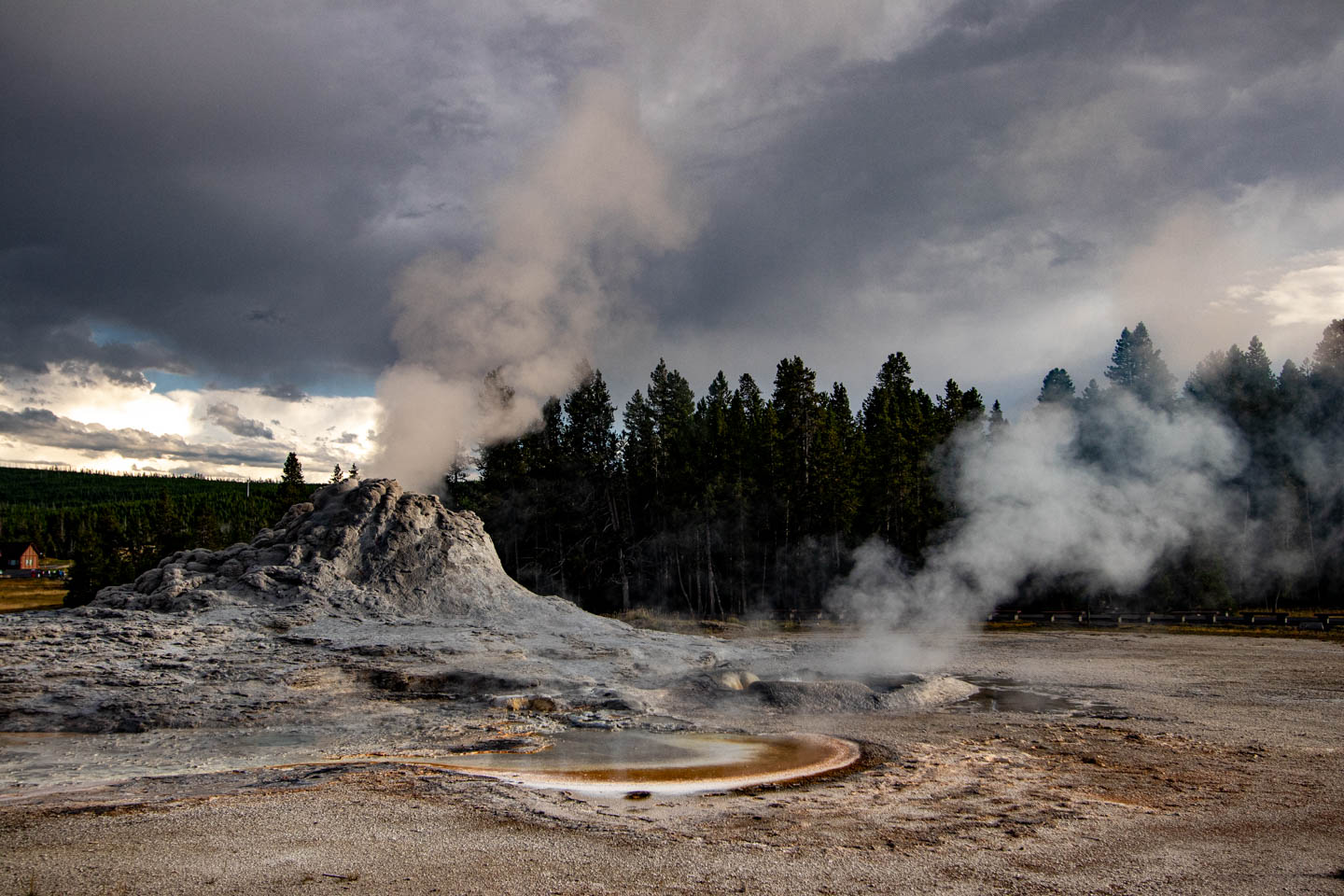
2. Lamar Valley – the cats’ greatest delight and my most powerful moment in the park
We saw Lamar Valley during our second morning in Yellowstone. It was that moment when you feel like you already “belong” to this place a little bit.
We drove in at first light. The entire valley was pink. The grasses looked like an ocean. The world smelled of dew.
And suddenly – a turn, brakes, silence. A herd of bison. Massive. Dozens, then hundreds.
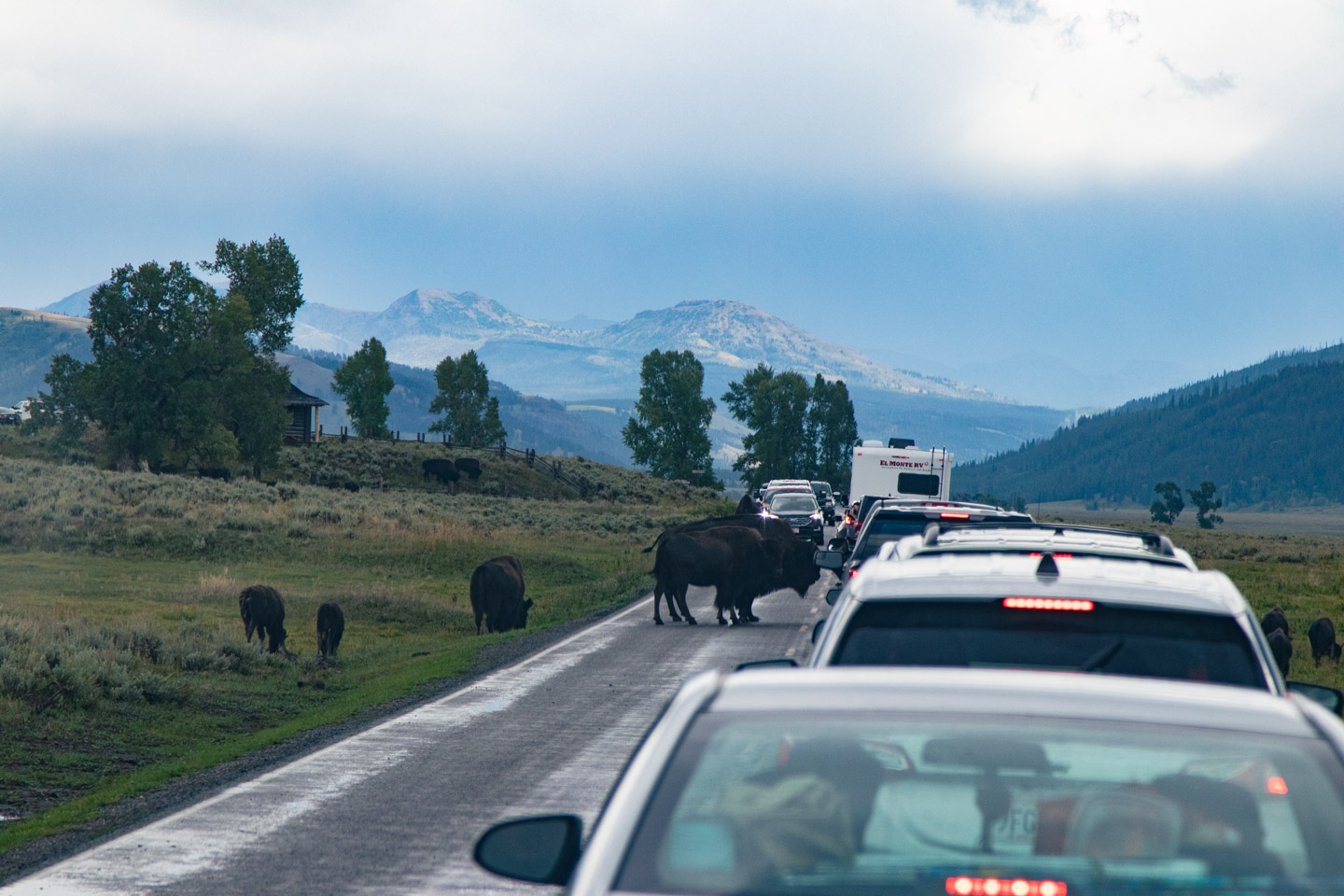
The cats sat in the window as if enchanted. They literally didn’t blink, as if they were watching their first IMAX movie ever.
And I watched their small green eyes dilated so wide they looked like two drops of glass.
The bison crossed so calmly, so majestically, that no one said a word. The sun created golden halos around their fur. It was like a scene from a movie, only more real.
Lamar Valley is exactly that: wild America without a filter. Nowhere before had I felt so strongly that we’re just guests here.
If you love observing wild animals in their natural habitat, also check out my guide to Utah’s 10 Most Beautiful Attractions, where wildlife meets dramatic landscapes.
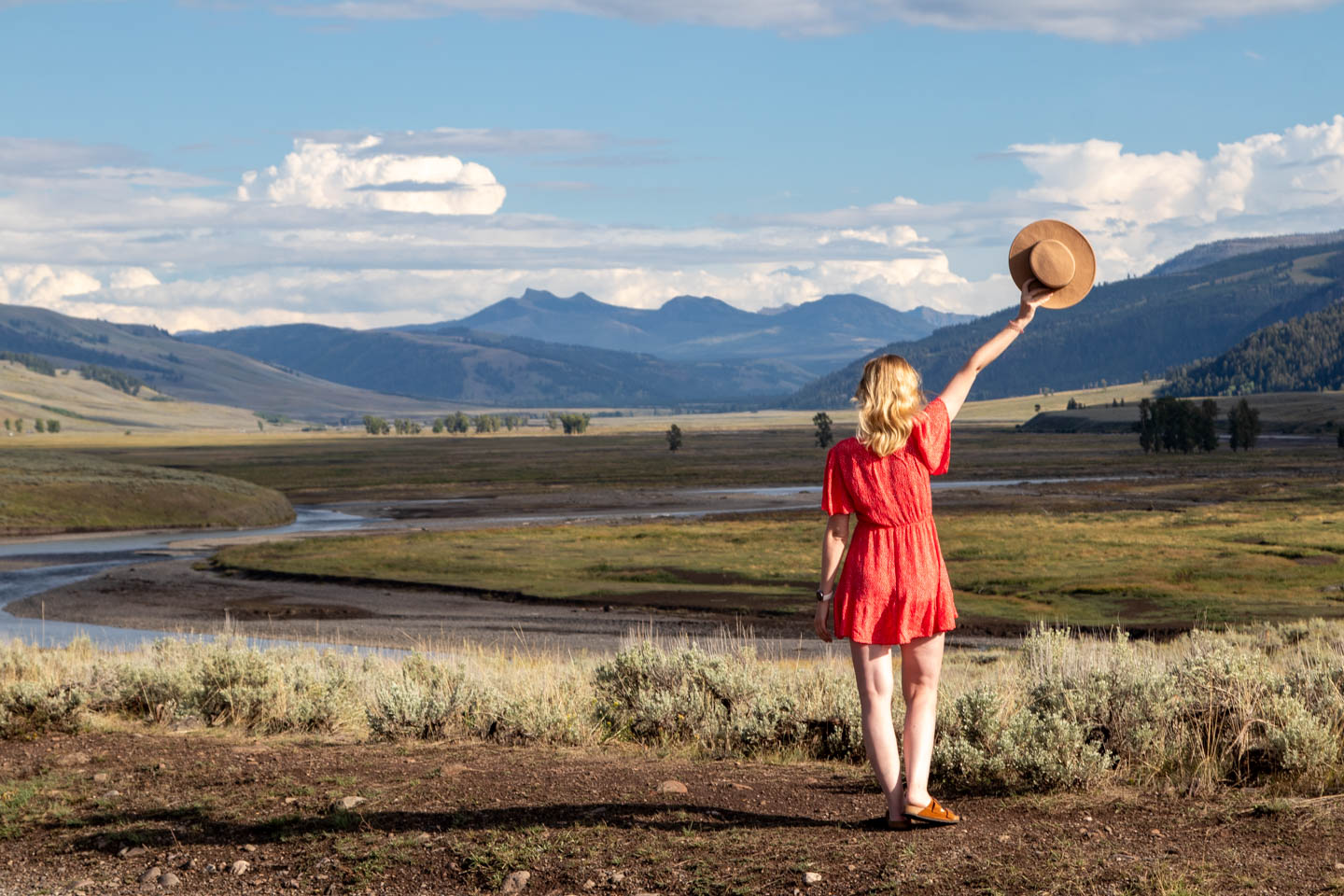
3. Mammoth Hot Springs – terraces that look like frozen light
On the third day we went to Mammoth Hot Springs. This place looks like petrified waves of light.
The terraces are white, honey-colored, golden – and when the sun hits at the right angle, they look like they’re glowing from within.
We walked on wooden boardwalks in silence. This is the kind of place where even cats would probably stop purring – if they could enter.
Here the geothermal activity is gentle, soft, sculptural. Each terrace looks like a different stage in the formation of the world.
It was the perfect place for a slow walk. And that’s exactly how we walked there – slowly, catching the light for photos, stopping just to look.
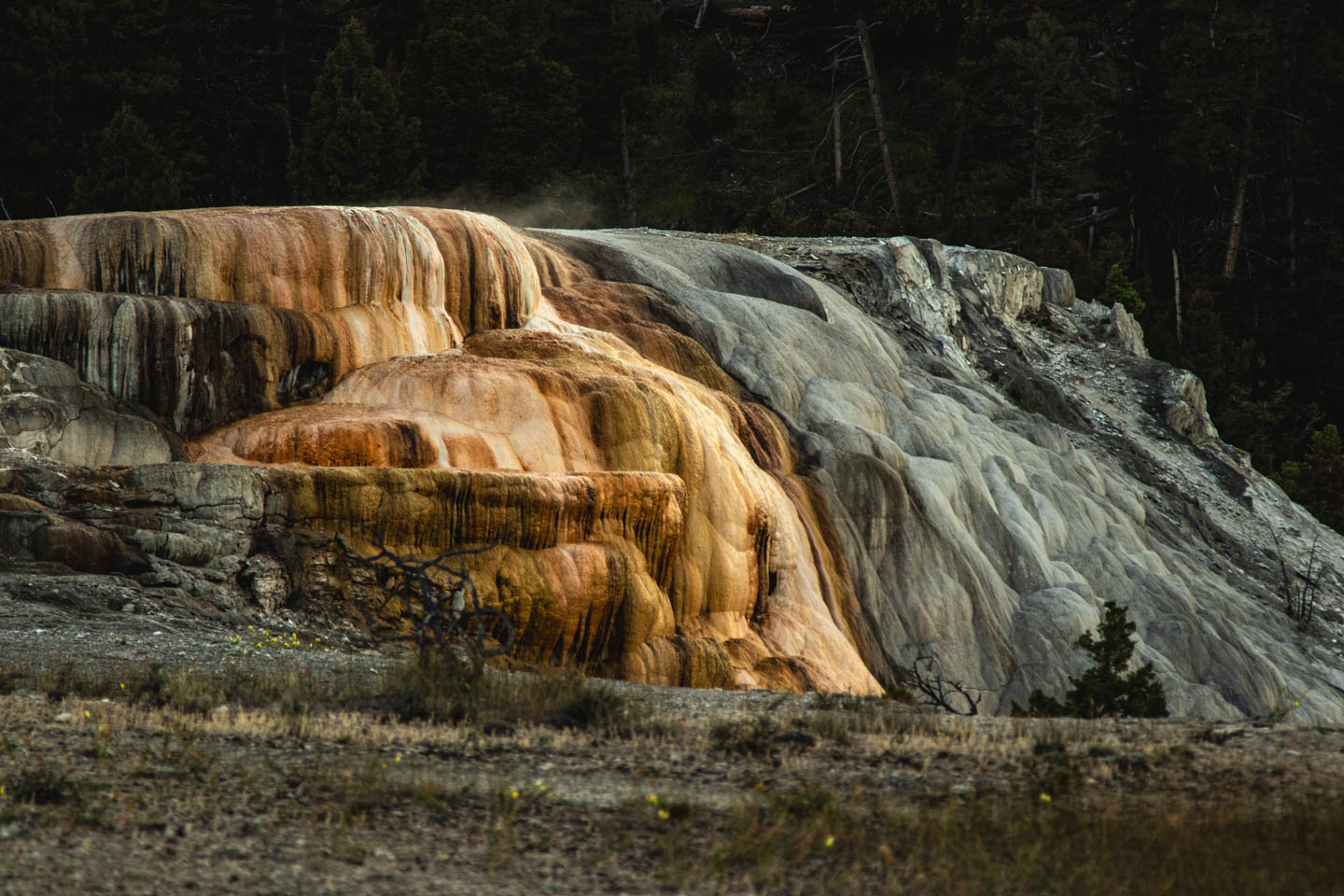
4. Hayden Valley – the valley that smelled of morning and peace
We saw Hayden Valley at sunrise, when fog hung low over the river like a milky ribbon. I still have that view under my eyelids.
This was our third night in the park, so in the morning we woke up with that warm feeling of “this landscape is a little bit mine now.”
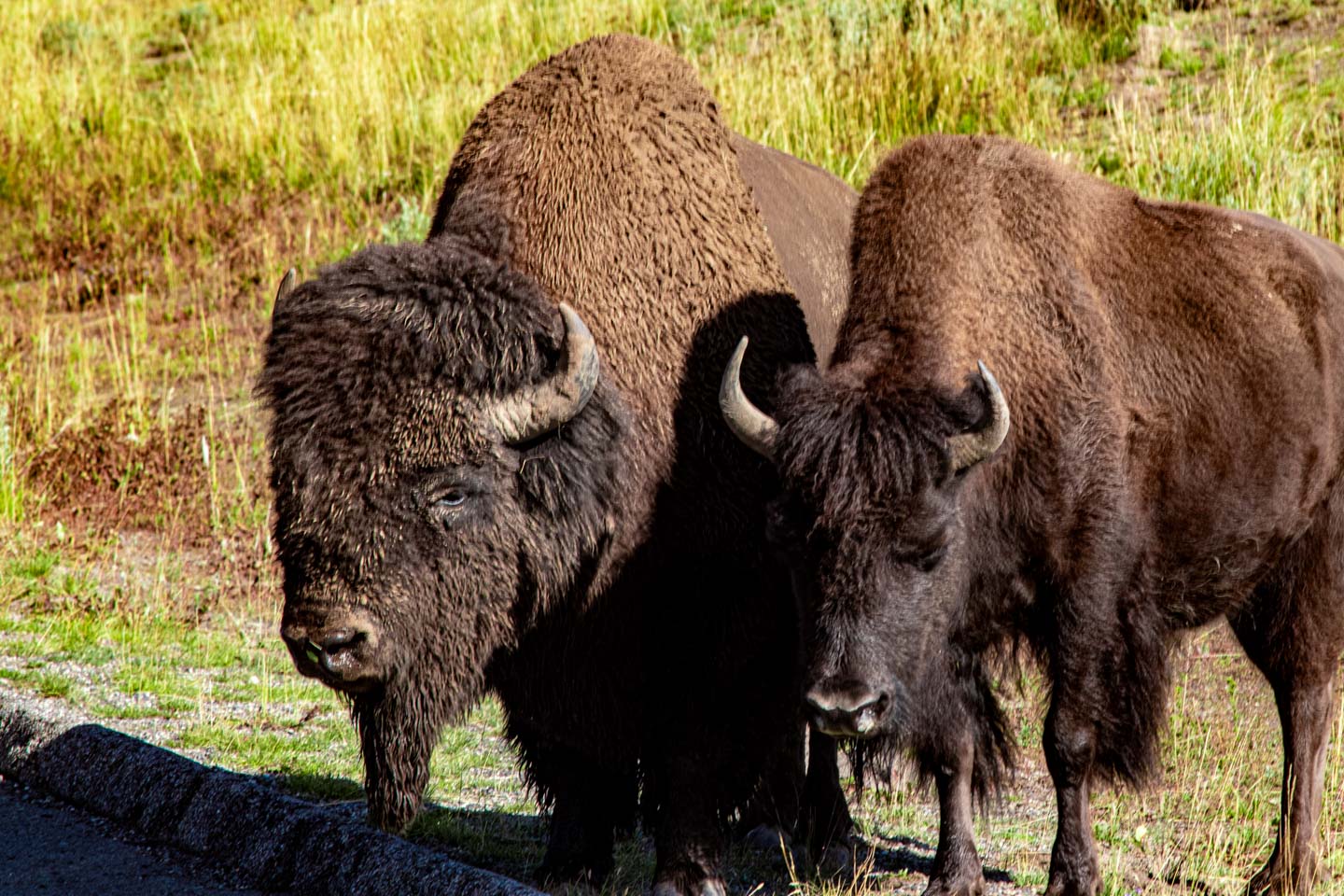
We made coffee in the camper van and headed straight to the valley.
Hayden is softer than Lamar. More pastel. More poetic.
And it was here that we first saw a grizzly bear. Far away, but clearly. A dark spot in the grass that moved with a grace I hadn’t suspected from such powerful animals.
People spoke in whispers. As if they knew there was something sacred in this silence.
Hayden is a place that gives you peace, but in such a way that you feel it long after you leave.

5. Grand Prismatic Spring – the most unreal color of my life
Grand Prismatic is one of those places people know from photos – and think “it probably looks different in person.”
It doesn’t look different. It looks more.
Even on approach you can smell the sulfur – intense, but somehow magical, promising that in a moment you’ll see something not from this planet.
Steam rises from the earth’s surface like the breath of a mythical creature.
But that’s just the beginning.
When I stood on the wooden boardwalk, I felt warmth under my feet and everything became… unnaturally beautiful.
Colors that shouldn’t go together – orange, gold, neon turquoise – arranged themselves into a perfect, organic pattern.
This doesn’t look like “water.” It looks like living, pulsing paint.
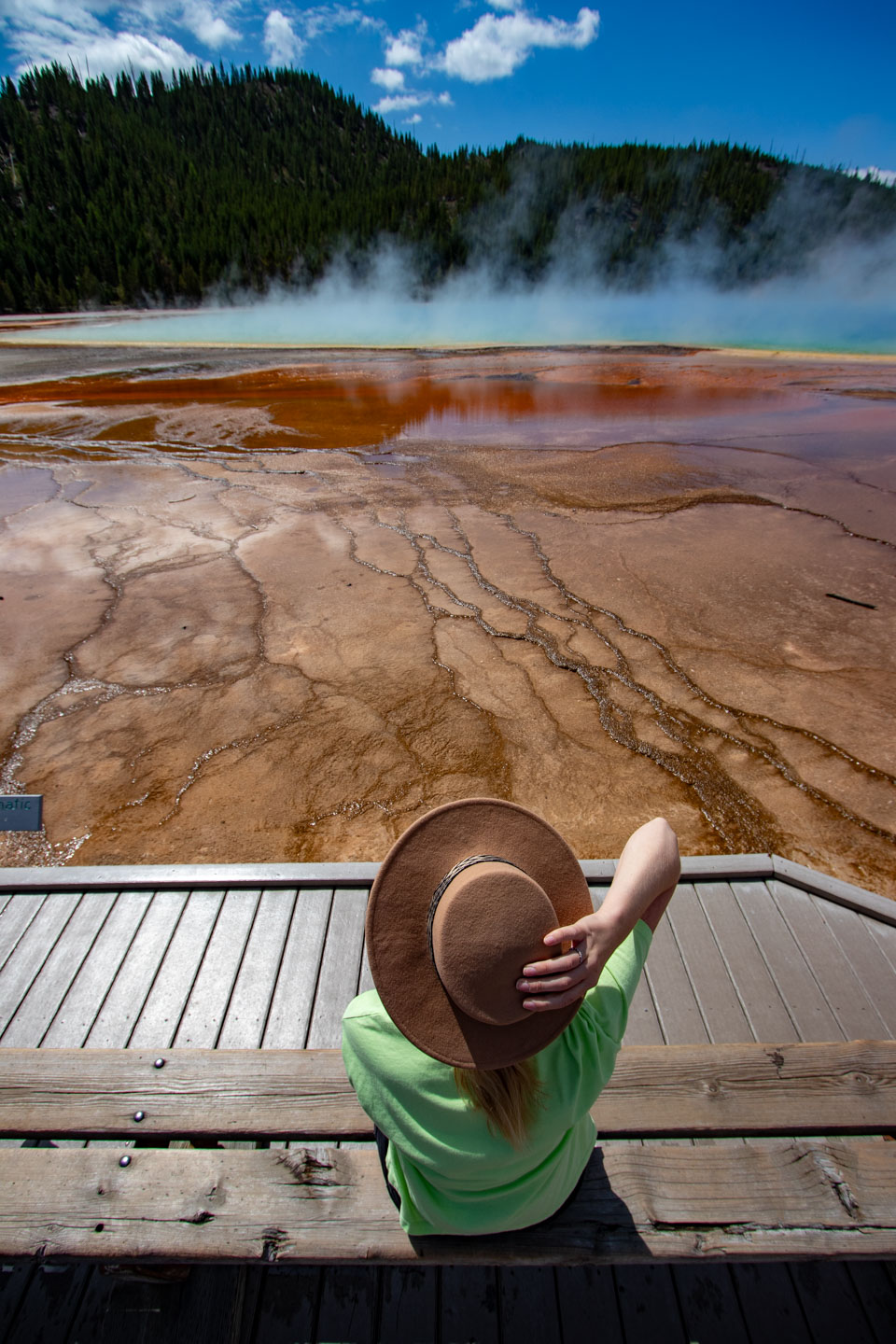
But the greatest wonder came on the Grand Prismatic Overlook trail.
We went there in the late afternoon when the light was soft and bright.
The cats stayed in the camper (at their honorary spot by the window), and we climbed to the viewpoint that literally took our hearts.
From above, Grand Prismatic looks like the eye of the planet. As if Yellowstone was looking at us, not the other way around.
I encourage you: go there without question. And better yet, go twice – in the morning and before sunset. They’re two different worlds.
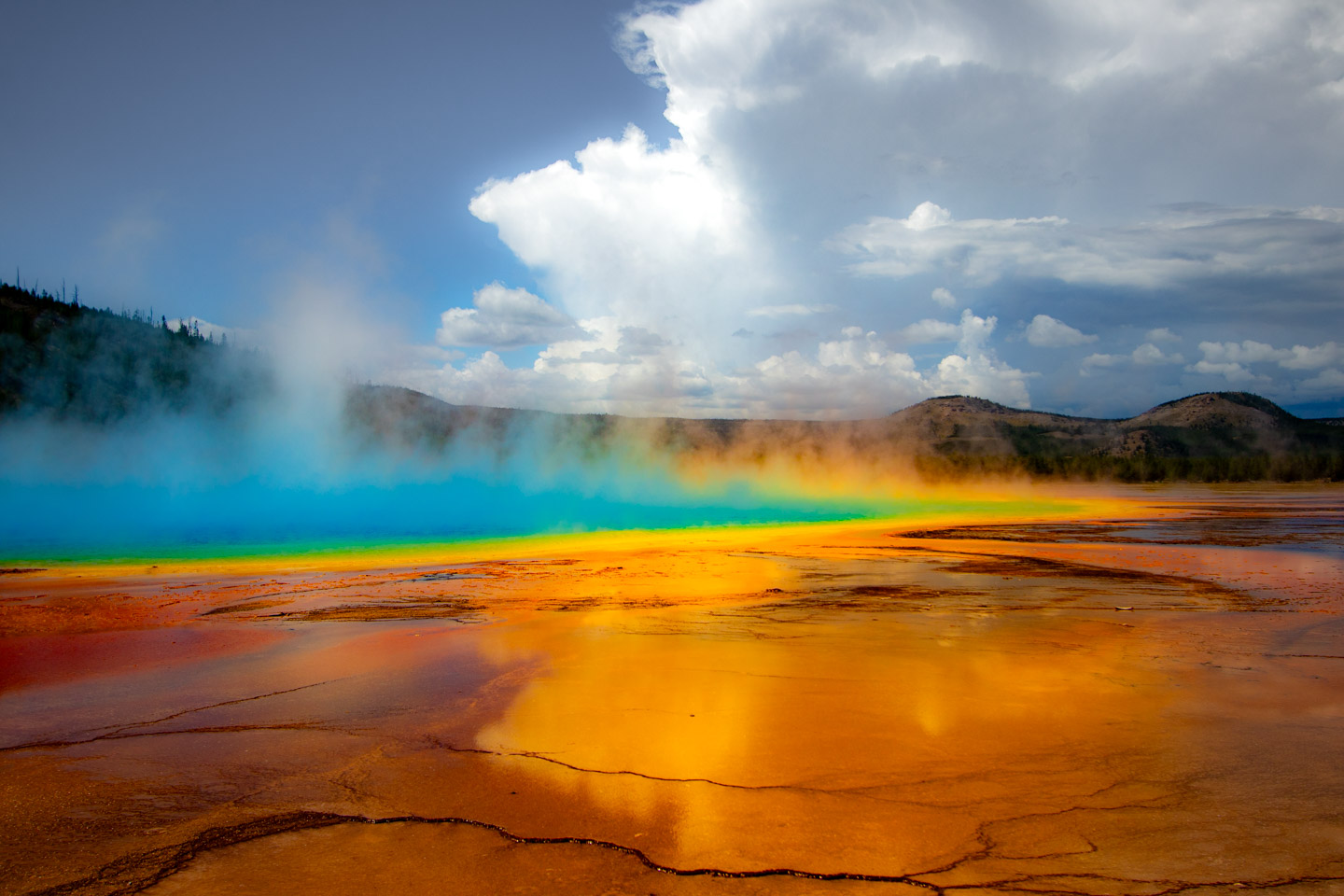
6. Grand Canyon of the Yellowstone – a place that looks like the inhale and exhale of nature
Yellowstone Canyon has nothing in common with what we know from American westerns. It’s more painterly, more subtle, more… golden.
The canyon walls are the color of ochre and old gold, as if someone scattered dust from an era we can’t imagine. The Yellowstone River flows below with powerful energy – you hear it before you see it.
The most beautiful spot is Artist Point. I stood there for a long time.
The sun fell in such a way that the mist rising from the waterfall looked like a delicate, silver fabric changing shape with every gust of wind.
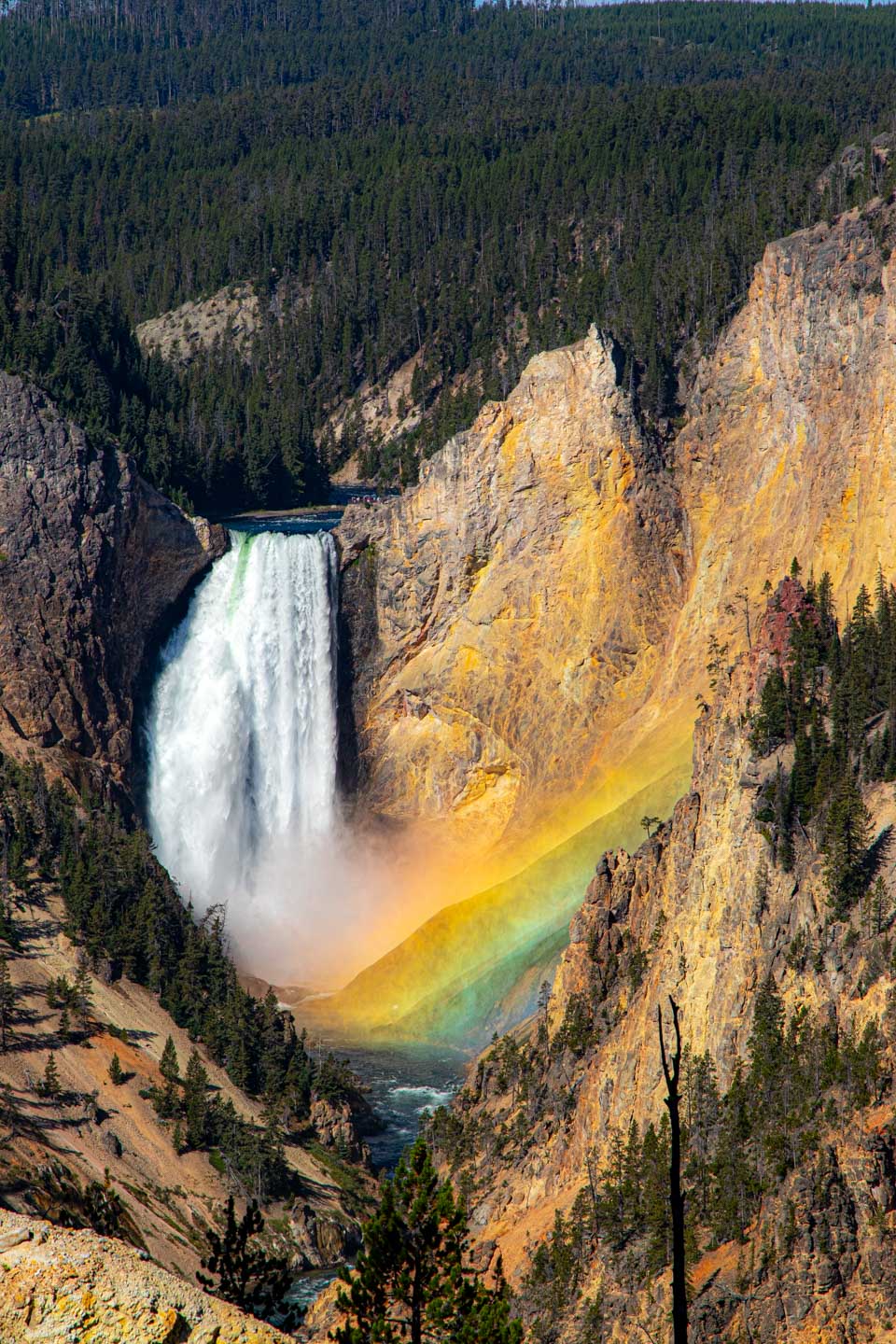
There was something very intimate about it. As if the entire landscape was breathing.
We later walked several short trails along the rim – each turn showed a different palette of colors, from soft pastels to dramatic shadows.
If you love photography – this place is like a box of different light filters.
Yellowstone Canyon doesn’t just look. It sounds and smells. It’s like a poem in landscape form.
When you fall in love with the colors of Yellowstone Canyon, you must see Utah – 7-Day Travel Itinerary, where similar rock formations create even more surreal landscapes.
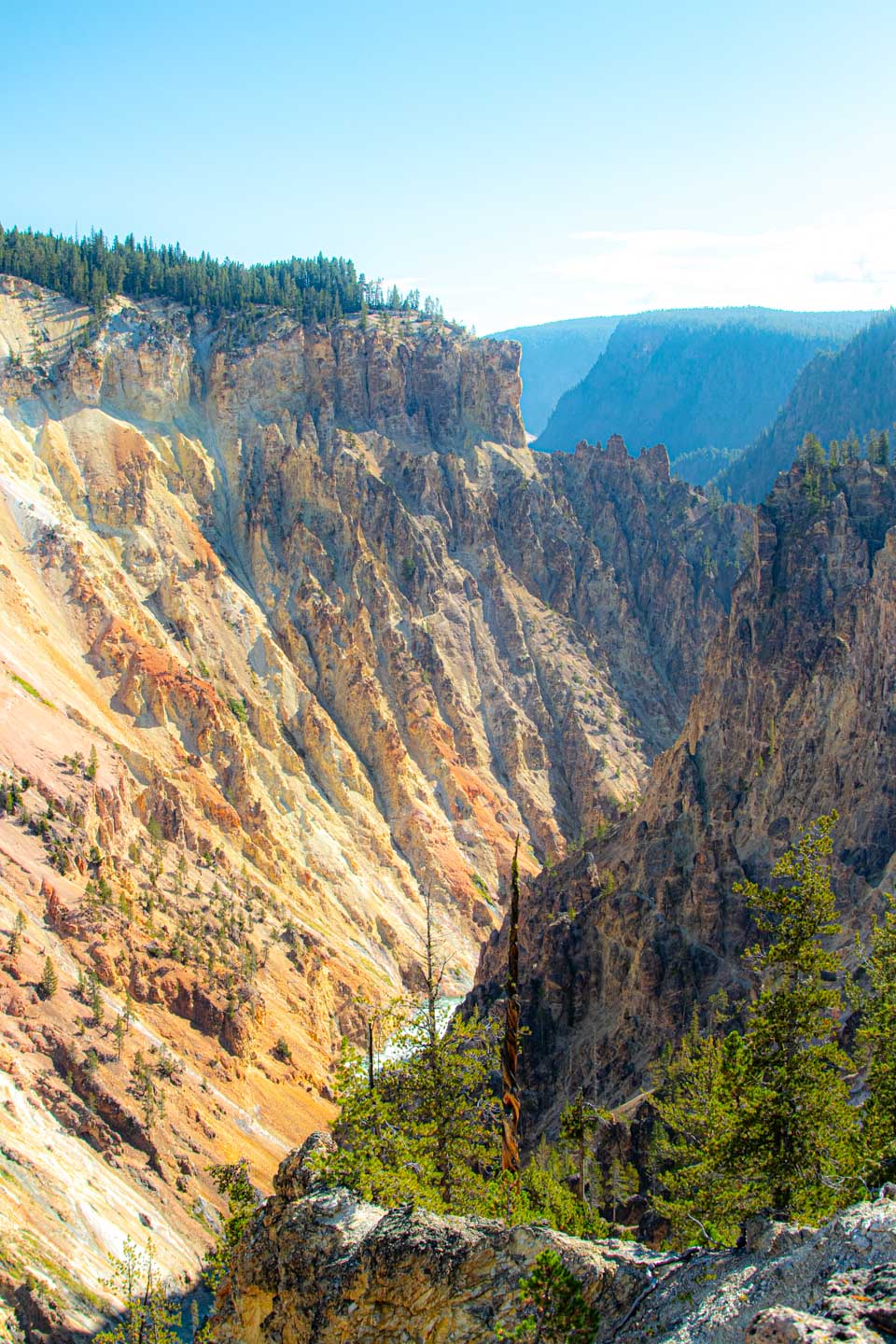
7. Lower Geyser Basin – dancing water, hissing earth, and bubbling mud
Lower Geyser Basin is the most “elemental” part of the park – one where nature shows its raw face.
Here the earth hisses. Here mud bubbles like a giant cauldron. Here steam bursts from the depths in a rhythm no one controls.
We got out of the camper van, the cats immediately pressed against the window (they liked the sound – seriously, they watched the geysers like television).
And I suddenly felt I was in a place that’s theatrical, dramatic, a bit menacing, but in a fascinating way.
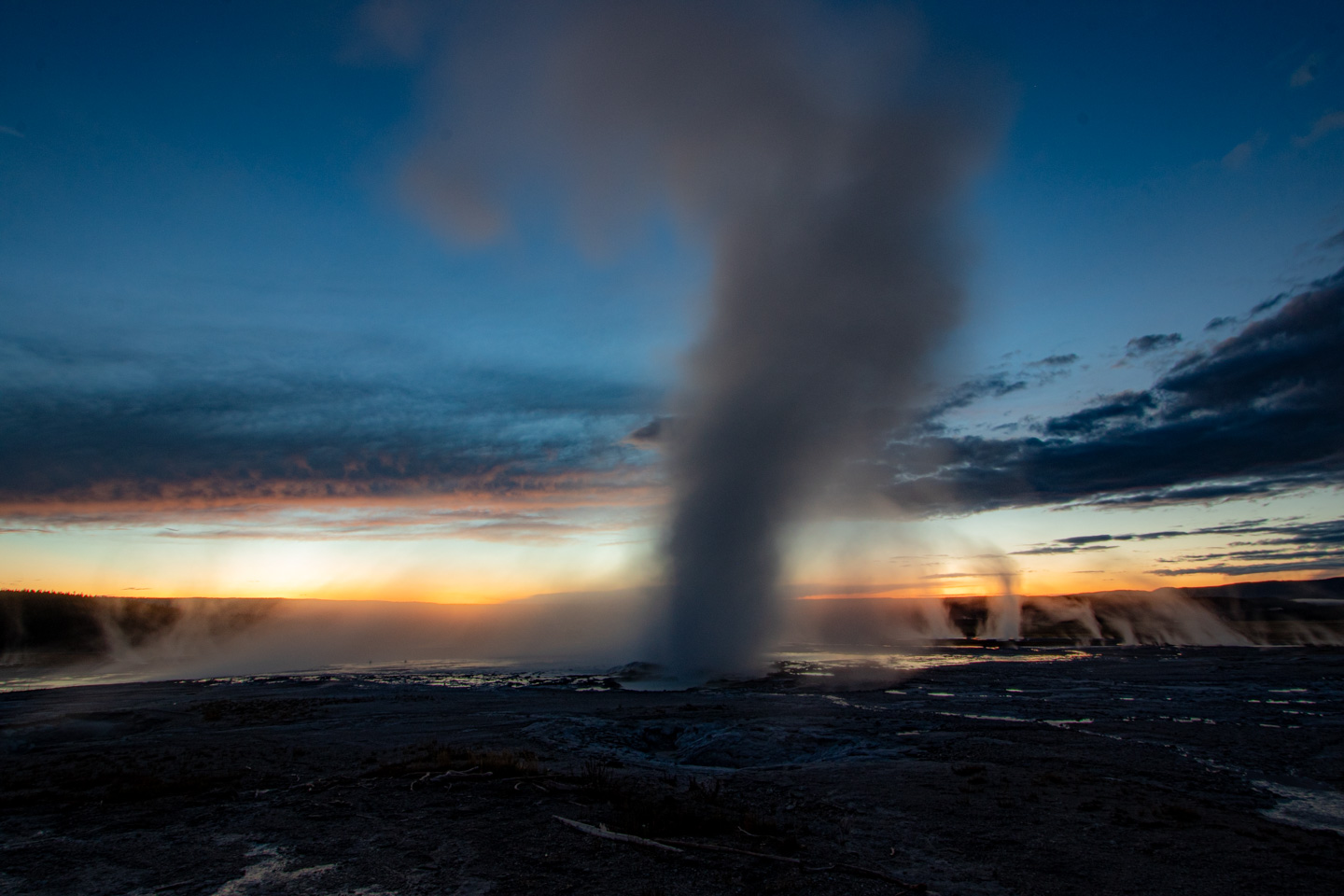
The most beautiful for me was Great Fountain Geyser. We stood by it before sunset, when the light turns pink. Its eruption was long, calm, majestic.
Water shot out with varying force, as if it had its own dance – sometimes gentle, sometimes violent.
The smell of sulfur mixed here with the scent of resin – a strange but beautiful combination. This was one of those places that makes you stop rushing.
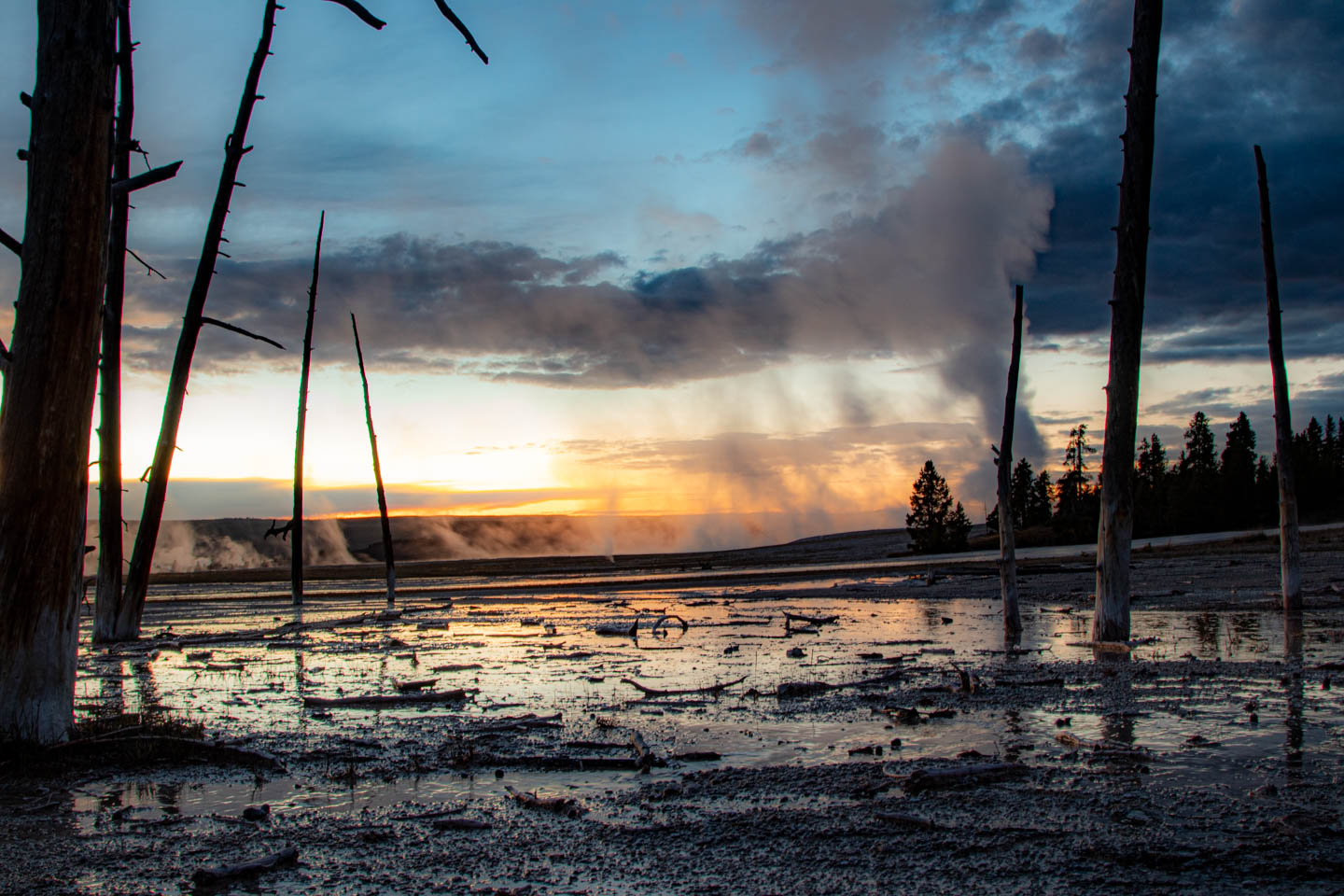
8. Yellowstone Lake – the cool heart of the park that soothes like a breath
After all that geyser intensity, the lake was like relief. Like a breath after too long a conversation.
Yellowstone Lake is huge – more like a sea than a lake. The water is the color of steel, and the shore is both harsh and delicate.
We sat there with Jan holding mugs of tea. The cats snuggled into us, tired from the day’s emotions.

The wind moved the waves so they looked like liquid glass.
The lake smelled of cold. It sounded like peace. This is the perfect place to stop, breathe, give yourself a moment between points.
If you have time – walk a bit along the shoreline path. If you have even more time – just sit.
This is one of the best places in the park for doing nothing.
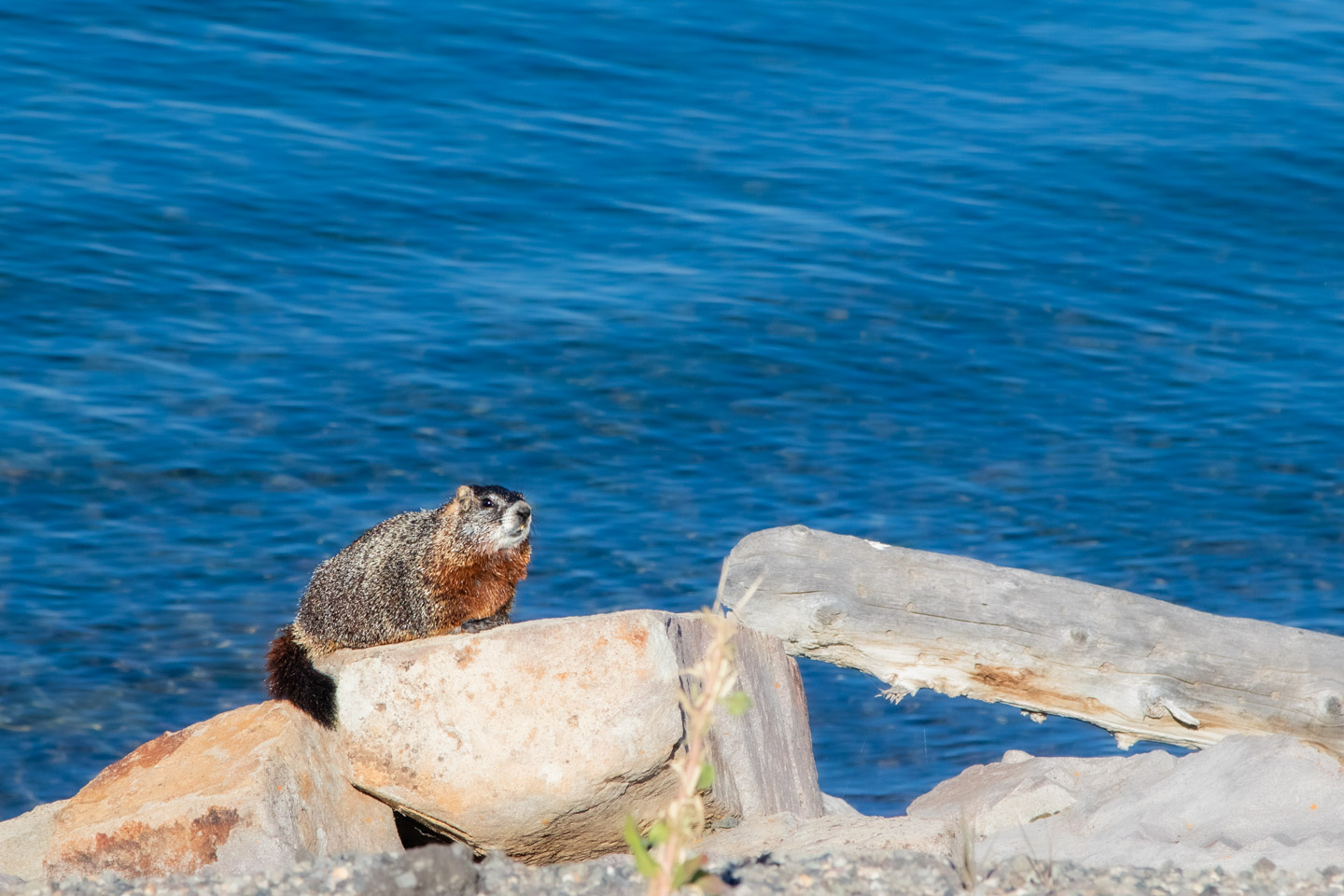
9. West Thumb Geyser Basin – two elements living side by side
West Thumb is a place where something inside you stops, because you don’t expect such phenomena can coexist.
Hot springs spouting steam… right next to the ice-cold surface of the lake.
We walked on wooden boardwalks that smelled of moisture and pine. The water in the lake was motionless, and right next to it, in the springs, it lived.
Steam, colors, warmth – everything danced right by the shore.
Abyss Pool – intensely blue, deep as a well, quiet, magnetic – was the most beautiful point for me. Like the eye of a creature looking into the depths of the earth.
West Thumb had something symbolic about it. Two elements side by side. Warm and cold. Movement and stillness. Intensity and calm.
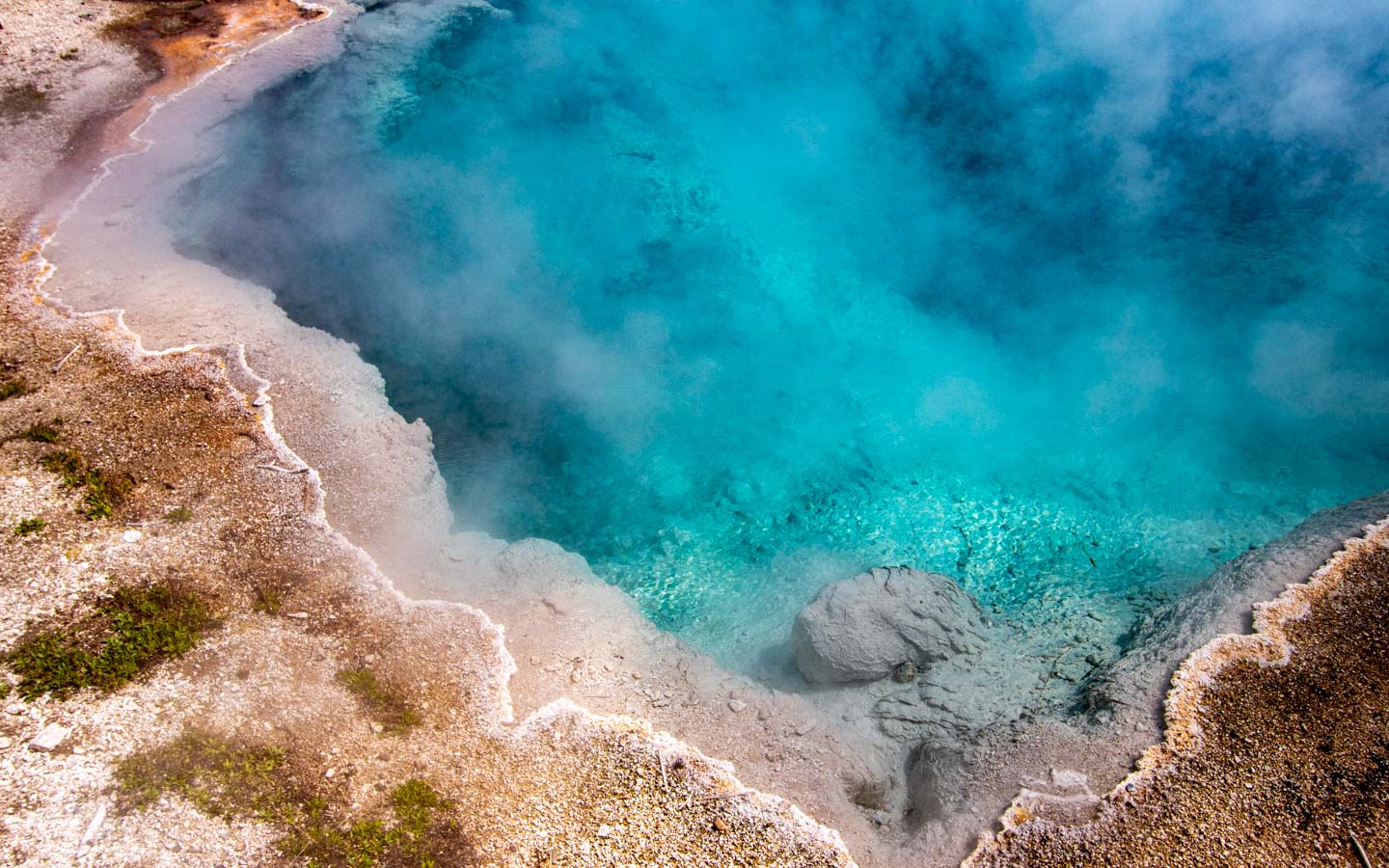
10. Black Sand Basin – the colorful finale of our journey
Black Sand Basin should be the last point for everyone – this place looks like a farewell written in colors.
Emerald Pool, Sunset Lake, Rainbow Pool – each has a different character. One intense as a jewel. Another soft, pastel. The third – changing like the moods of the sky.
Black rocks contrast with neon colors, creating scenery like from a science fiction film.
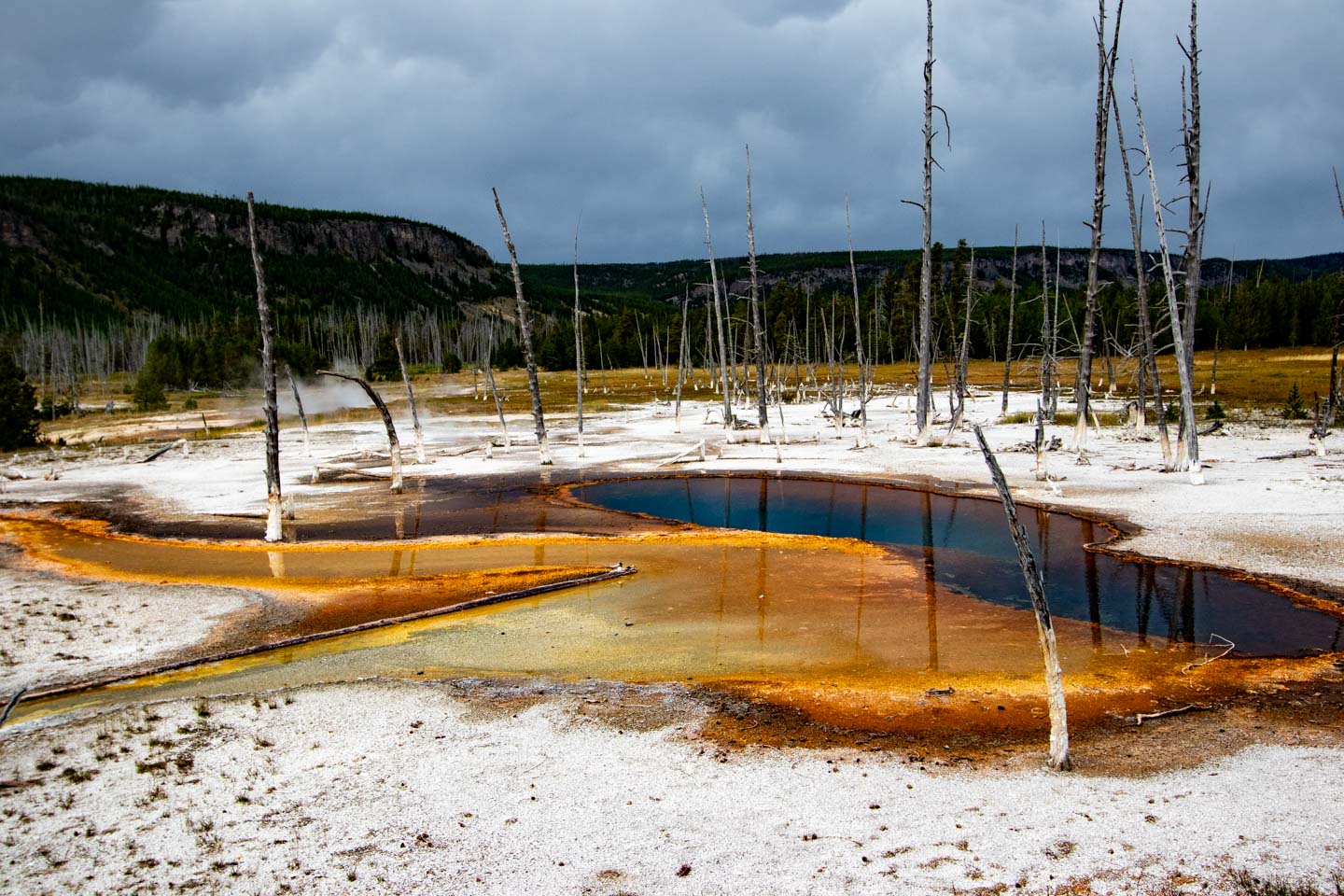
Steam dances over the water. The sulfur smell is light, even elegant. Everything looks like nature’s show for those who stayed until the last minutes of the day.
We were there when the sun began to set. Light reflected off the springs so all the colors were more saturated.
The cats, tired from the whole day, slept like angels, and I thought only one thing: “Thank you that we could see this.”
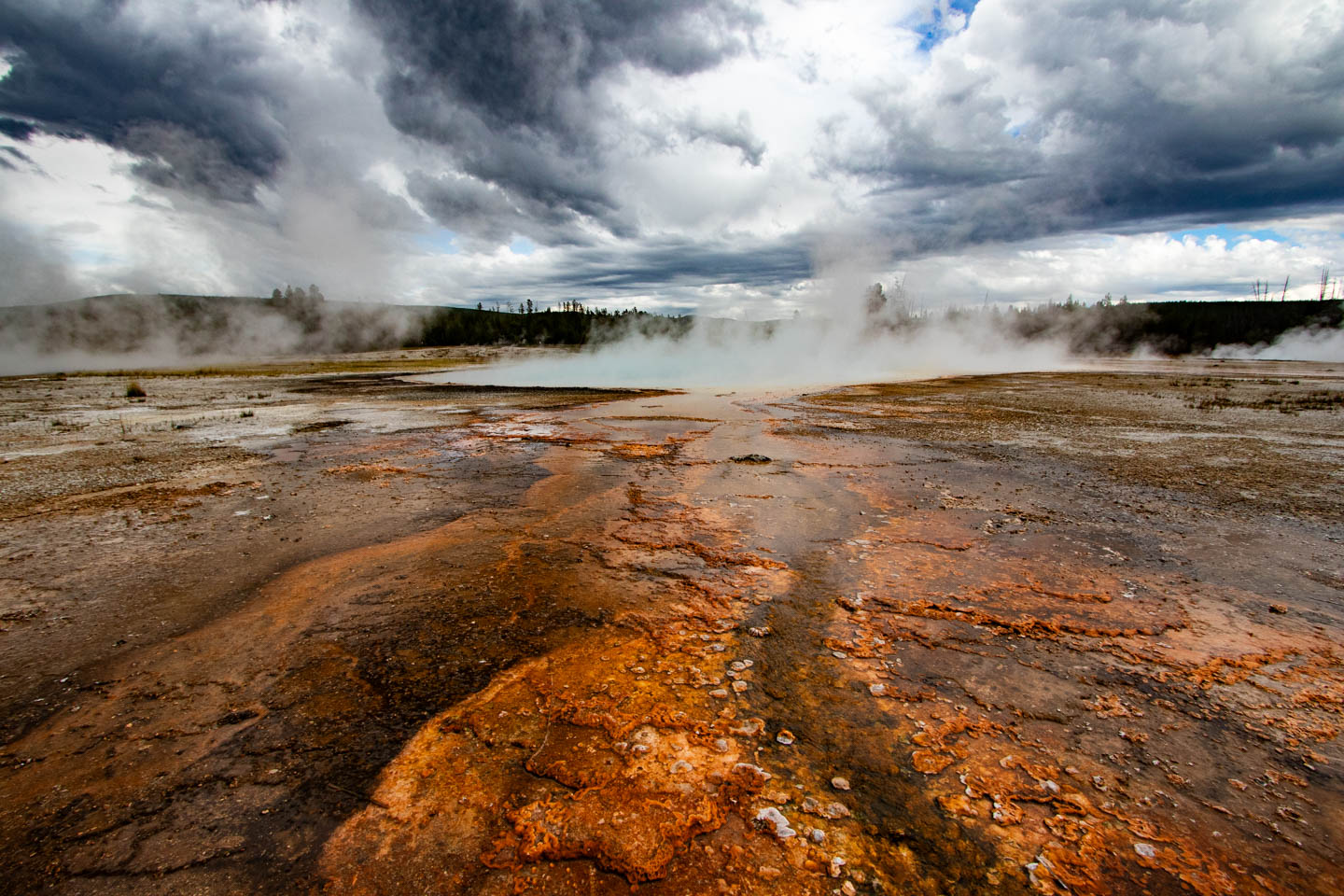
How do you want to explore America?
🏞️ National Parks Adventure → 10 Amazing Things to Do in Yosemite – My personal tested hiking trails and photography spots
🌊 Pacific Coast Highway → 7-Day California Coast Itinerary – Every scenic stop and hidden beach I discovered
🌲 Pacific Northwest Explorer → 10-Day Oregon & Washington Guide – Waterfalls, forests, and coastal magic
🏜️ Southwest Desert Experience → Arizona Road Trip – From red rocks to slot canyons
What type of American adventure calls to you most?
When to visit Yellowstone? Best time for your trip
Yellowstone has its seasons, its moods, and its rhythms.
The most beautiful time is June through September, when most roads are open, trails are accessible, and mornings smell of resin and coolness.
We were there in August – days were warm, but nights truly cold.
In the camper we slept under two blankets, and the first rays of sun had something soft about them, as if they woke the entire park very slowly.
If you like quiet and lack of crowds, September is also beautiful.
In winter Yellowstone looks magical, but many places are then closed and accessible only with a guide.
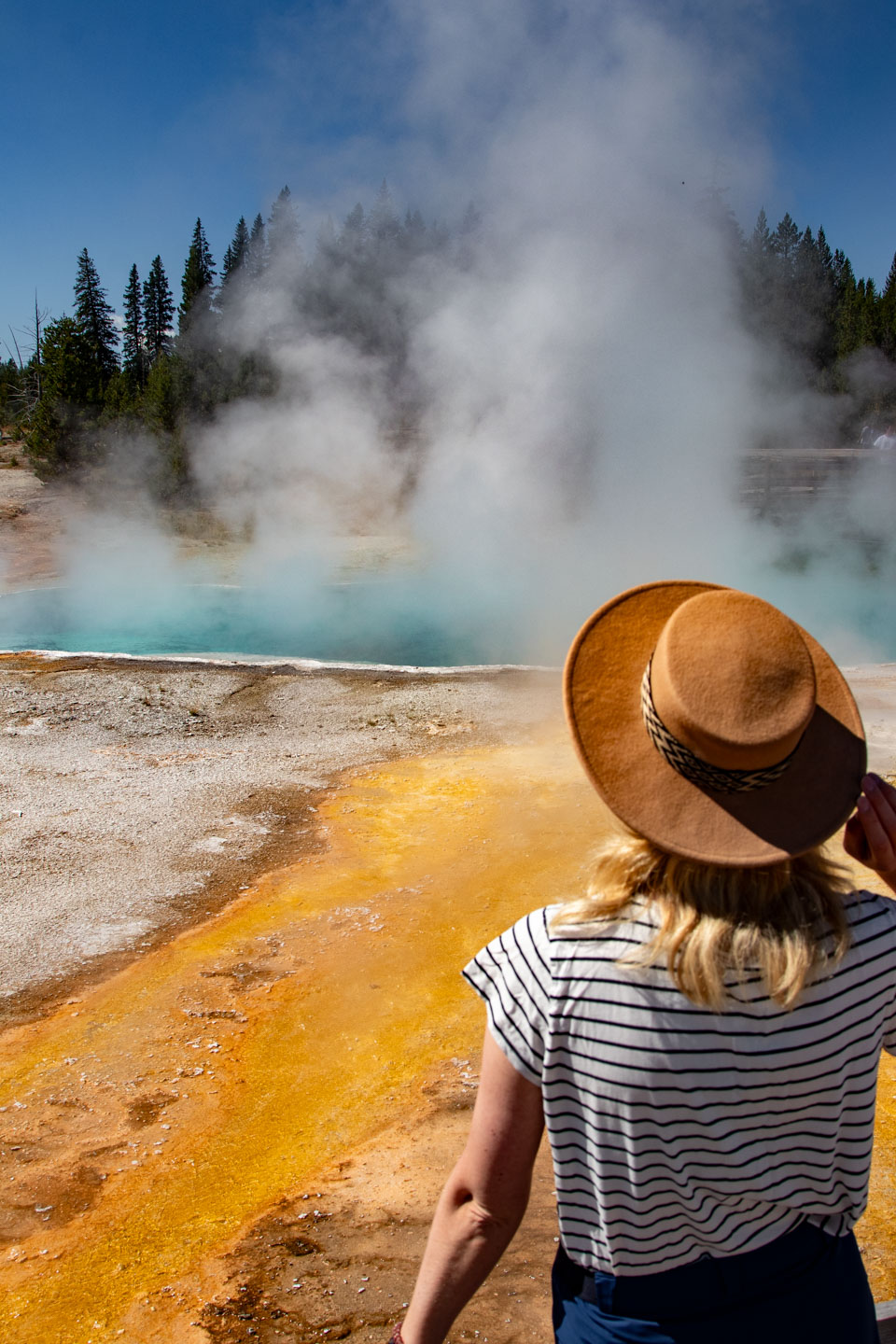
How to get around Yellowstone?
This is one of those parks you really appreciate having your own transportation.
Yellowstone is huge – driving from one geothermal area to another can take 30-60 minutes, and sometimes longer if a herd of bison walks onto the road.
Best ways to explore the park:
- by car
- by camper van
Traffic in the park is calm, but remember that most people start their day at the same time.
It’s worth leaving early in the morning before the parking lots start filling up.
If you’re planning a road trip through national parks, check out my complete guide to traveling in the USA, where you’ll find all the practical information about car rentals and planning routes.
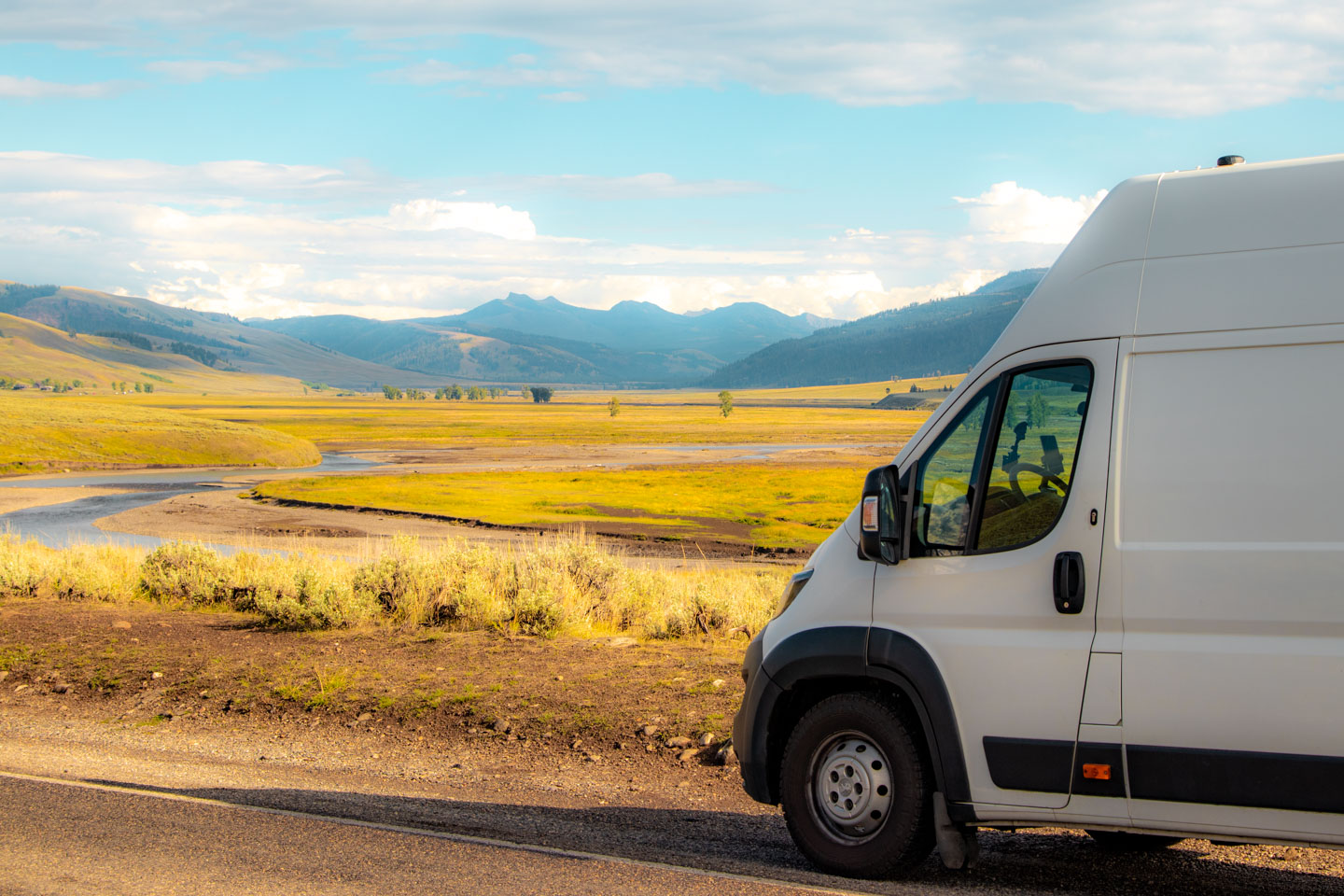
How many days do you need in Yellowstone?
You can see the “attractions” in 1 day, but that’s a bit like eating dessert without the main course.
- minimum: 2-3 days
- ideal: 4-5 days
- most beautiful: several nights in the park or right next to it
We spent several nights here in the camper and it changed the entire experience.
We could return to places at different times of day: Grand Prismatic at dawn looks like another planet, and Hayden Valley in evening light is something absolutely magical.
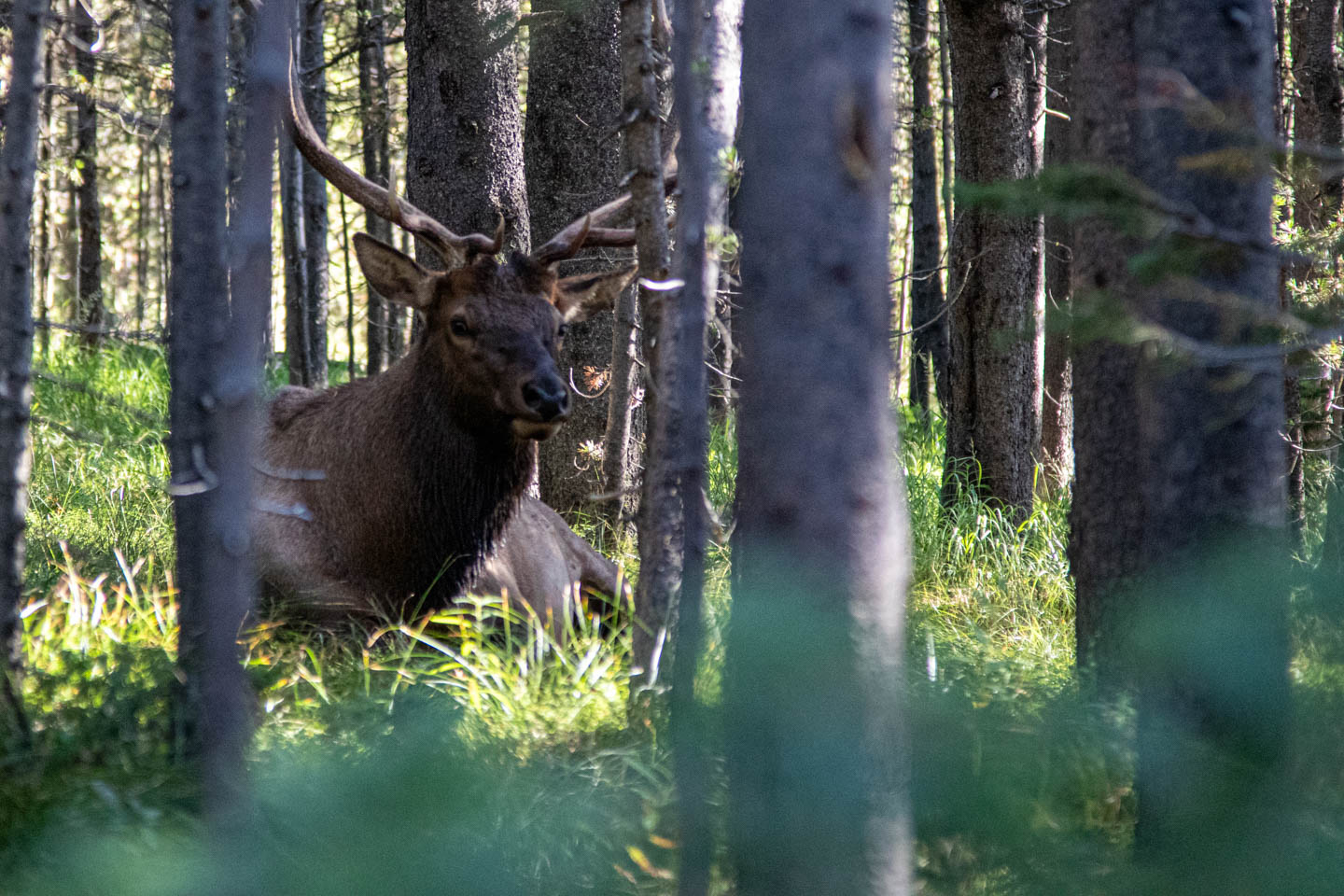
Where to stay in Yellowstone?
If you can – sleep in the park.
Silence, cool air, night sky, and mornings that look like the world is starting anew – no hotel can give you that.
Best options:
Campgrounds in Yellowstone (book early!)
- Madison
- Canyon
- Grant Village
- Mammoth
These have atmosphere – campfires, the smell of wood, and closeness to nature.
The cats slept in the camper like two little loaves of bread, and in the morning they watched a herd of deer through the window as if hypnotized.
Hotels right by the park
If you prefer comfort:
- West Yellowstone – most convenient access to most attractions
- Gardiner – quieter pace and beautiful views
- Cody – great for a road trip, but farther from main points
Everything depends on your travel style.
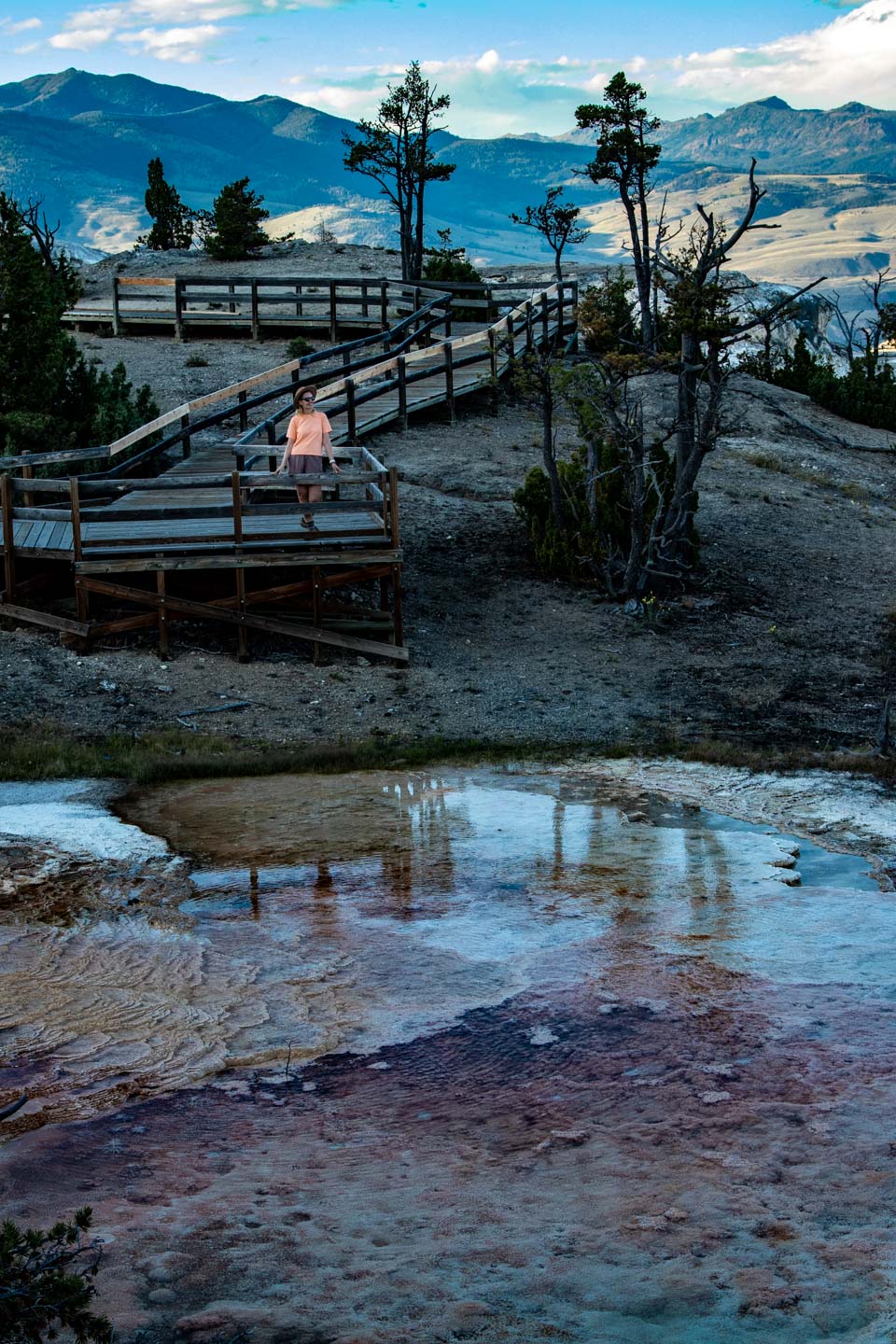
Useful tips for Yellowstone
These are a few things that really make a difference:
- arrive early – morning light is most beautiful
- fill up your tank – gas stations in the park are expensive and rare
- bring warm clothes – even in summer nights are cold
- keep distance from animals – bison look gentle but can run 37 mph
- bison traffic jams are normal – treat them as part of the experience
- bring a thermos – drinking coffee at sunrise in Hayden Valley is an experience in itself
- don’t plan too much for one day – the park is too beautiful to “check off”
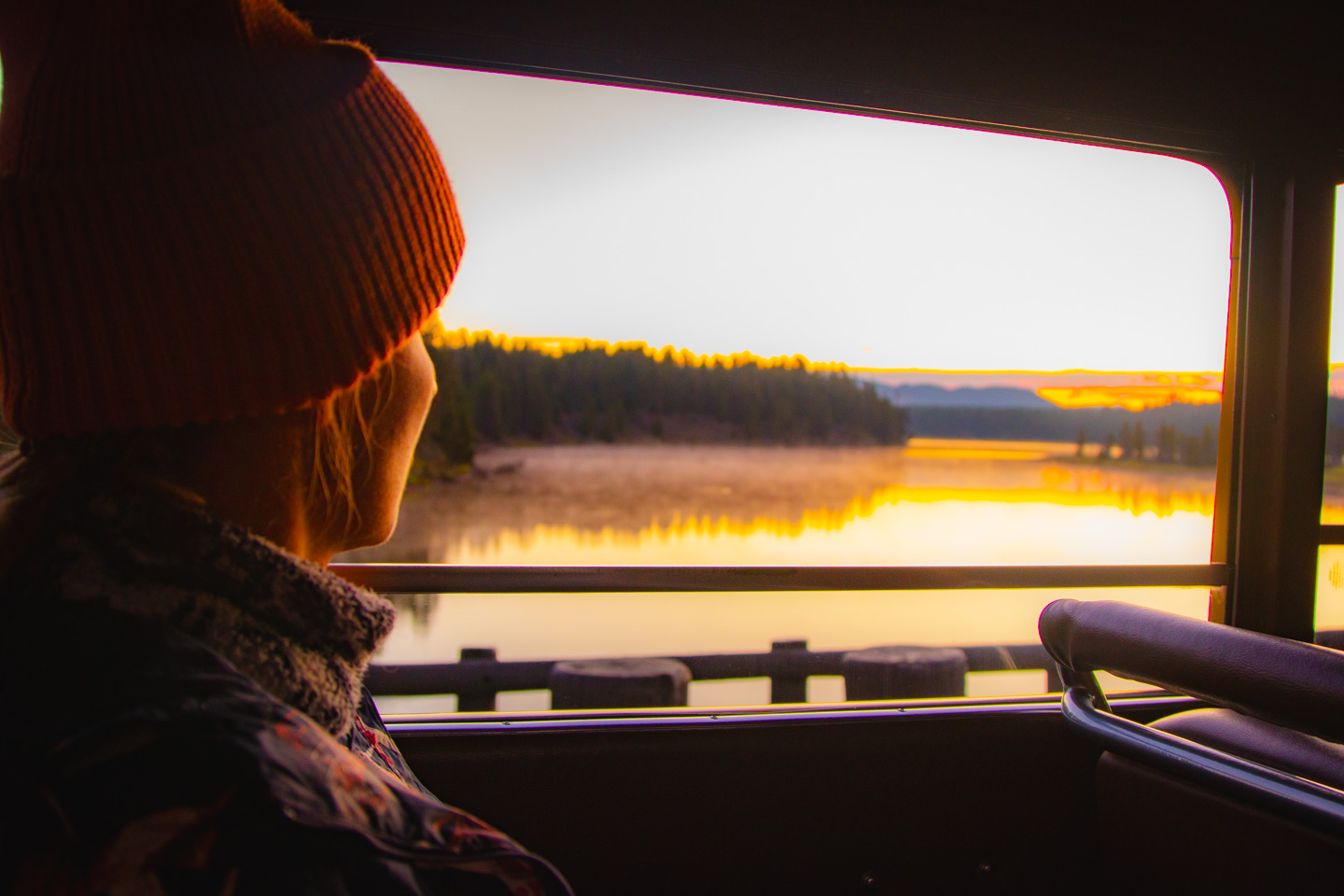
Frequently asked questions about Yellowstone
Can you see Yellowstone in one day?
You can see a few places, but the park is too big to capture its atmosphere in one day. It’s best to stay 2-4 days.
Is Yellowstone safe?
Yes, if you keep your distance from animals and don’t leave designated geothermal paths. The park has bears, bison, and wolves.
What animals can you see in Yellowstone?
Most commonly bison, elk, moose, pronghorn, grizzly bears, coyotes, and countless bird species.
Yellowstone – a place that stays forever
Yellowstone wasn’t just a park for me. It was a lesson in humility, gratitude, and presence.
After several days spent in its rhythm – waking at dawn, slow walks on wooden boardwalks, evenings with warm tea in the camper – I felt something I hadn’t felt in a long time: that I was truly here and now.
The cats learned to watch bison with quiet fascination. Jan took thousands of photos but kept repeating “you have to see this with your own eyes.” And me… I was just grateful.
Yellowstone reminded me that the most beautiful journeys aren’t about places you “check off.” They’re about moments that change you.
About sunrise over Lamar Valley when the world is still sleeping. About mist rising from Grand Prismatic like the planet’s breath. About a quiet evening over Yellowstone Lake when everything smells of peace.
If you’re planning your trip, stay open to surprises. Yellowstone shows itself differently every day – and sometimes every hour.
Travel Budget Calculator
Get your free Travel Budget Calculator now and plan your trip without the stress of overspending!
Don’t Want to Read? Watch the Video!
Which place in Yellowstone sounds most fascinating to you? Or maybe you’ve been there and have your favorite spot? Let me know in the comments – I love reading your stories!
If this guide was helpful, share it with someone who dreams of Yellowstone. Let this magic reach further!
